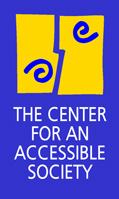
DISABILITY
ISSUES
INFORMATION
FOR
JOURNALISTS
TOPICS
ABOUT
THE CENTER
One in five working age adults said they had a disability, according to 1999 data released by the Centers for Disease Control and Prevention in March, 2001.
The Center analysed responses from more than 53,000 adults aged 18 years or older, and found
22% reporting having a functional limitation.
Nearly one in six of those people had difficulty seeing words or letters in newsprint, reported the CDC.
Almost as many (15.7%) reported difficulty hearing normal conversation. And almost 44 percent reported difficulty climbing stairs.
According to the CDC report, the prevalence rate of disability was 24% among women and 20% among men. Approximately 32 million adults had difficulty with one or more functional activities such as
The full report is available online. It's in the CDC's Morbidity and Mortality Weekly Report of February 23, 2001 / 50(07);120-5 at http://www.cdc.gov/mmwr/preview/mmwrhtml/mm5007a3.htm
DO THESE PEOPLE NEED PERSONAL ASSISTANTS?
While this study did not ask that question, data from earlier studies gives a clue. People in the U.S. get 21 billion hours of assistance annually, 31 hours per week on average, says the National Institute on Disability and Rehabilitation Research's Disability Statistics Center, associated with the University of California San Francisco -- fewer than half of the 13.2 million who get help with things like bathing, dressing and heavy housework are over 65 years old, says DSC director Mitchell LaPlante. (Reporters may contact LaPlante for interviews at laplant@itsa.ucsf.edu or at 415-502-5214.)
Using data from the 1994-95 National Health Interview Survey from the National Center for Health Statistics, the Disability Statistics Center, a National Institute on Disability and Rehabilitation Research Center reported two years ago that:
14.8 million adults in the U.S need help with things like bathing, dressing, heavy housework. Over13 million (13.2) do receive some help with these things, but mostly in the form of informal, unpaid services, primarily from a family member. Few are able to rely on public funding to pay someone to provide these services (see Medicaid findings below).
13.2 million adults -- FEWER THAN HALF OF THEM ELDERLY -- receive 21 billion hours of assistance annually, 31 hours pers week on average. Most get their assistance from informal providers; not paid assistants.
Only 24.3 percent of this total get paid assistance -- on the average of18 hours a week.
Most assistance is unpaid -- 88.4 percent -- averaging 31 hours a week.
6.9 million non-elderly people (ages 18-64) need assistance (the hours of assistance they need averages to 53 hours a week)
But only 15 percent of these people get any paid assistance. The average number of hours of paid assistance these people get is 17 hours.
Non-elderly people who need assistance get less paid assistance than do older people.
6.2 million people age 65+ need assistance; the hours of assistance they need averages to 71 hours of assistance a week.
Slightly over a third (37.5%) of these people get paid assistance. The average number of hours of paid assistance these people get is 18 hours.
Of all the people who need assistance, Medicaid paid most of the cost for [only]127,000 people and some of the cost of [only] 232,000 people in the U.S.
For more information:
The
Disability Statistics Center at the University of California at San Francisco
Mitchell P. LaPlante, Ph.D., Director
Dr. LaPlante is Associate Adjunct Professor in the Department of Social and Behavioral Sciences and the Institute for Health & Aging. His research interests include conceptual and definitional issues in health and disability, the demography and epidemiology of health and disability, and health and disability policy.
Email:laplant@itsa.ucsf.edu
Phone: 415-502-5214
Fax: 415-502-5208
OTHER ITEMS OF INTEREST:
The following sites contain information that may be of interest. Please bear in mind that the information at these sites is not controlled by the Center for An Accessible society. Links to these sites do not imply that the Center supports either the organizations or the views presented.
The following information is available from InfoUse:
Chartbook on Women and Disability in the United States
Chartbook on Work and Disability in the United States
The latest publication in the Chartbook series, "Chartbook on Women and Disability in the United States," is a reference on national statistical information on gender and disability. All the charts and text from this chartbook are available on-line, and you may also download the entire chartbook in PDF format for printing. Last updated: 07/21/99.
InfoUse has recently published the "Chartbook on Work and Disability in the United States," a reference on national statistical information on work disability. All the charts and text from this chartbook are available on-line, and you may also download the entire chartbook in PDF format for printing. Last updated: 03/19/99. Note: Some charts have been updated with 1998 CPS data. Chartbook on Disability in the United States
InfoUse has published a revision of its "Chartbook on Disability in the United States," a reference on national statistical information on disability. This section of our Web site includes Chartbook excerpts, with an electronic version of the entire chartbook available for downloading in PDF format. Last updated: 11/12/98.
Overview
The 'new paradigm' of disability
Read Deborah Kaplan on the definitions of disability
Research on disability definitions from NIDRR